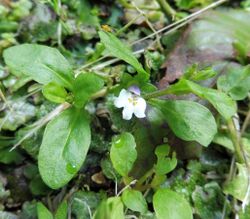Biology:Mazus pumilus
| Mazus pumilus | |
|---|---|

| |
| Scientific classification | |
| Kingdom: | Plantae |
| Clade: | Tracheophytes |
| Clade: | Angiosperms |
| Clade: | Eudicots |
| Clade: | Asterids |
| Order: | Lamiales |
| Family: | Mazaceae |
| Genus: | Mazus |
| Species: | M. pumilus
|
| Binomial name | |
| Mazus pumilus (Burm. f.) Steenis
| |
Mazus pumilus, commonly called Japanese mazus,[1] is a species of flowering plant in the Mazaceae family. It is native to south and east Asia, where it is found in Bhutan, China , India , Pakistan , Indonesia, Japan , Korea, Nepal, New Guinea, the Philippines , Russia , Taiwan, Thailand, and Vietnam.[2] It is an invasive species in North America.[1]
Its natural habitat is wet grasslands, streambanks, and trailsides.[2] It is tolerant of disturbance, and can be found in areas such as cultivated fields, sidewalk cracks, and waste ground.[2][3] It is a very common species in Japan.[4]
It is an upright annual growing to 30 cm tall. Its flowers are purple and white with yellow spots on the throat. Flowers are produced throughout the growing season.[2]
References
- ↑ 1.0 1.1 "Mazus pumilus". Natural Resources Conservation Service PLANTS Database. USDA. https://plants.usda.gov/core/profile?symbol=MAPU7. Retrieved 6 September 2018.
- ↑ 2.0 2.1 2.2 2.3 Mazus pumilus Flora of China
- ↑ Mazus pumilus (in Japanese), Okayama University Plant Ecology Laboratory
- ↑ Ohwi, Jisaburo (1965). Flora of Japan. Smithsonian Institution. p. 795.
Wikidata ☰ Q3010889 entry
 |

